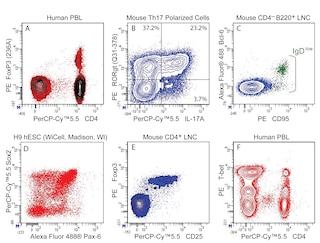Old Browser
This page has been recently translated and is available in French now.
Looks like you're visiting us from {countryName}.
Would you like to stay on the current country site or be switched to your country?




.png)

Flow cytometric analysis of Eos expression in mouse splenic regulatory T lymphocytes. Spleen cells from C57BL/6 mice were stained intracellularly with Alexa Fluor® 647 Rat Anti-mouse Foxp3 (Cat. No. 560401 or 560402), Alexa Fluor® 488 Rat Anti-Mouse CD4 (Cat. No. 557667) and either PE Rat IgG2a, κ Isotype Control (Cat. No. 554689; Top Row) or PE Rat Anti-Eos (Cat. No. 566747; Bottom Row) at 0.06 μg/test using BD Pharmingen™ Transcription Factor Buffer Set (Cat. No. 562725 or 562574). Left Column: Two-parameter flow cytometric dot plots showing the correlated expression of Eos (or Ig isotype control staining) versus CD4 were derived from events with the forward and side light-scatter characteristics of intact leukocytes. Right Column: Two-parameter flow cytometric dot plots showing the correlated expression of Eos (or Ig isotype control staining) versus Foxp3 were derived from CD4+ gated events with the forward and side light-scatter characteristics of intact leukocytes. Flow cytometry and data analysis were performed using a BD LSRFortessa™ Cell Analyzer System and FlowJo™ software. Data shown on this Technical Data Sheet are not lot specific.

Flow cytometric analysis of Eos expression in human regulatory T lymphocytes. Peripheral blood mononuclear cells were stained intracellularly with Alexa Fluor® 647 Mouse anti-Human FoxP3 (Cat. No. 560045 or 560889), BV421 Mouse Anti-Human CD4 (Cat. No. 562424 or 562425) and either PE Rat IgG2a, κ Isotype Control (Cat. No. 554689; Top Row) or PE Rat Anti-Eos (Cat. No. 566747; Bottom Row) at 0.06ug/test using BD Pharmingen™ Transcription Factor Buffer Set (Cat. No. 562725 or 562574). Left Column: Two-parameter flow cytometric dot plots showing the correlated expression of Eos (or Ig isotype control staining) versus CD4 were derived from events with the forward and side light-scatter characteristics of intact lymphocytes. Right Column: Two-parameter flow cytometric dot plots showing the correlated expression of Eos (or Ig isotype control staining) versus FoxP3 were derived from CD4+ gated events with the forward and side light-scatter characteristics of intact lymphocytes. Flow cytometry and data analysis were performed using a BD FACSCelesta™ Cell Analyzer System and FlowJo™ software. Data shown on this Technical Data Sheet are not lot specific.
.png)

BD Pharmingen™ PE Rat Anti-Eos

BD Pharmingen™ PE Rat Anti-Eos
.png)
Regulatory Status Legend
Any use of products other than the permitted use without the express written authorization of Becton, Dickinson and Company is strictly prohibited.
Preparation And Storage
Product Notices
- Since applications vary, each investigator should titrate the reagent to obtain optimal results.
- An isotype control should be used at the same concentration as the antibody of interest.
- Caution: Sodium azide yields highly toxic hydrazoic acid under acidic conditions. Dilute azide compounds in running water before discarding to avoid accumulation of potentially explosive deposits in plumbing.
- For fluorochrome spectra and suitable instrument settings, please refer to our Multicolor Flow Cytometry web page at www.bdbiosciences.com/colors.
- Alexa Fluor® is a registered trademark of Molecular Probes, Inc., Eugene, OR.
- Species cross-reactivity detected in product development may not have been confirmed on every format and/or application.
- Please refer to www.bdbiosciences.com/us/s/resources for technical protocols.
Companion Products



.png?imwidth=320)


The W7-486 monoclonal antibody specifically recognizes mouse and human Eos. Eos is a member of the Ikaros family of zinc-finger transcription factors that play important roles in hematopoietic cell development and tumor suppression. Other members of the Ikaros family include Ikaros, Helios, Aiolos, and Pegasus. Eos is encoded by the IKAROS family zinc finger 4 (mouse Ikzf4 and human IKZF4) genes. This DNA-binding transcription factor forms homodimers and heterodimers with other Ikaros family members. In the peripheral immune system, Eos expression is predominantly in CD4-positive FoxP3-positive Treg cells, where it is involved in the negative regulation of gene expression. It has been reported that Eos is co-expressed with Helios, but not with Aiolos, in Treg cells. Upon in vitro activation, FoxP3-negative, CD4- or CD8-positive T lymphocytes may express Eos.

Development References (3)
-
Pan F, Yu H, Dang EV, et al. Eos mediates Foxp3-dependent gene silencing in CD4+ regulatory T cells. Science. 2009; 325(5944):1142-1146. (Biology). View Reference
-
Raffin C, Pignon P, Celse C, Debien E, Valmori D, Ayyoub M. Human memory Helios- FOXP3+ regulatory T cells (Tregs) encompass induced Tregs that express Aiolos and respond to IL-1β by downregulating their suppressor functions. J Immunol. 2013; 191(9):4619-27. (Biology). View Reference
-
Rieder SA, Metidji A, Glass DD, et al. Eos Is Redundant for Regulatory T Cell Function but Plays an Important Role in IL-2 and Th17 Production by CD4+ Conventional T Cells. J Immunol. 2015; 195(2):553-63. (Biology). View Reference
Please refer to Support Documents for Quality Certificates
Global - Refer to manufacturer's instructions for use and related User Manuals and Technical data sheets before using this products as described
Comparisons, where applicable, are made against older BD Technology, manual methods or are general performance claims. Comparisons are not made against non-BD technologies, unless otherwise noted.
For Research Use Only. Not for use in diagnostic or therapeutic procedures.
Report a Site Issue
This form is intended to help us improve our website experience. For other support, please visit our Contact Us page.